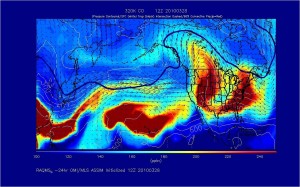Black carbon made by emissions from coal plants, forest fires, and diesel engines, and other greenhouse gases and atmospheric pollutants are being studied in the upper atmosphere. The HIAPER Pole-to-Pole Observation (HIPPO) is studying the earth’s atmosphere, pole to pole, vertically and across latitudes.
Supported by the National Science Foundation, the National Oceanic and Atmospheric Administration, NASA and a number of universities, HIPPO began a series of flights in 2009. The moving lab has conducted studies over the planet. After watching globally through all seasons researchers found that during winter and spring, “a giant pool of CO2 grows in the Northern Hemisphere as photosynthesis slows and as fossil-fuel CO2 emissions and plant and soil respiration continue.” This is particularly true at high altitudes in the Arctic.
HIPPO has made it possible to accurately measure trends and locations for over 100 gases. They found that black carbon was found to be widespread and evenly distributed in the Northern Hemisphere at high altitudes. Also nitrous oxide (N2O) is higher than expected in the mid- and upper-tropical troposphere than on the surface.
Black carbon, though short-lived, affects climate by absorbing solar radiation and by forming clouds that will either reflect or absorb radiation, depending on their characteristics and locations. Black carbon usually remains close to the earth’s surface. However, HIPPO observed elevated levels of the pollutant at almost all altitudes in the Arctic, but especially at higher altitudes.
Another surprise was the seasonality of black carbon-laden pollution at mid-latitudes between Hawaii and Alaska. During springtime, the pollutant is derived from two main sources — human-made from Asia and biomass burning from Southeast Asia. “Even more surprising, we discovered that this pollution extended over the entire depth of the troposphere — from near the surface of the ocean to 28,000 feet.”
To learn more, go to Hauser, Rachel. “A HIPPO Takes to the Skies to Taste Earth’s Atmosphere,” National Center for Atmospheric Research Live Science, October 14, 2011. http://www.livescience.com/16559-hippo-atmosphere-testing-nsf-bts.html


Comments are closed.